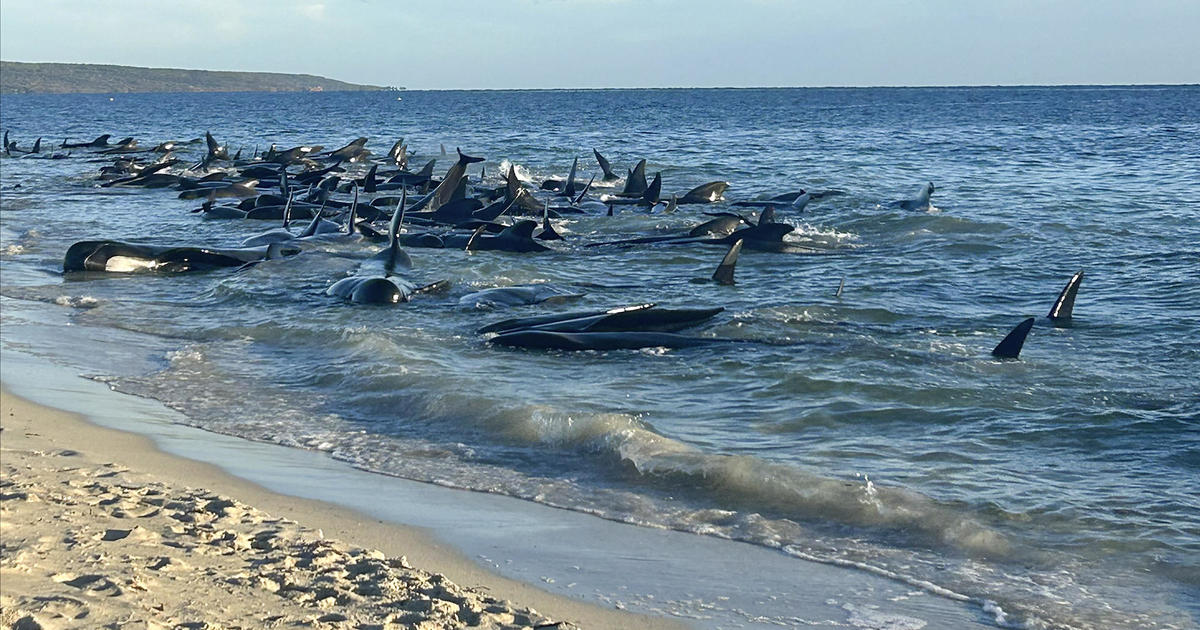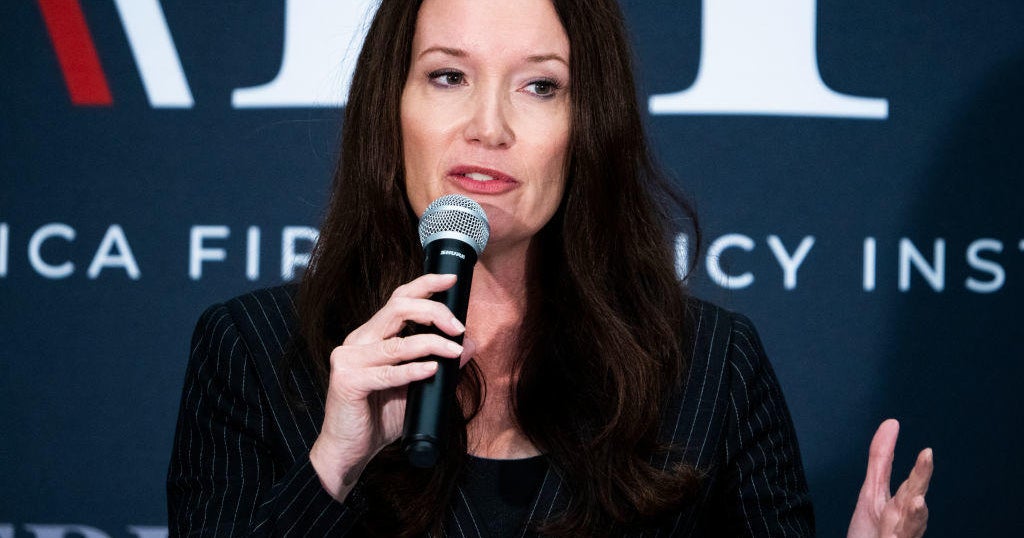CBS News
29 beached pilot whales dead after mass stranding on Australian coast; more than 100 rescued

A mass stranding of long-finned pilot whales in southwestern Australia led to the deaths of 29 of the beached creatures on Thursday, officials said. Another 100 or so of the whales were rescued and redirected out to sea from Toby’s Inlet, which is at the lower tip of Western Australia, about 150 miles from Perth, the state capital.
Images released Thursday by Western Australia’s Parks and Wildlife Service showed a large group of pilot whales crowded together at the edge of the Toby’s Inlet shoreline, where the ocean meets the land. Although many were still submerged in the very shallow water, several of the whales were fully beached.
Department of Biodiversity, Conservation and Attractions via AP
Wildlife officers, marine scientists and veterinarians were deployed to the site. Just before noon, the parks and wildlife service reported that four pods of as many as 160 pilot whales were stranded in the water and spread across an area of roughly 1,600 feet, with 26 whales stranded on the beach itself.
“Our team is making every effort to safely respond and keep volunteers and staff safe, while also acting in the best interests of the whales,” the wildlife service said as they worked to manage the situation. “Our team is assessing the conditions of the whales that have stranded on the beach. Our teams on the water are trying to keep the animals together and away from the beach.”
Officials said originally that the beached whales would likely need to be euthanized, based on previous similar incidents. Last July, dozens of whales belonging to the same species died on a different beach in Western Australia after becoming stranded. In the end, the wildlife service said that 51 whales had died of the 96 that were stranded.
Ian Wiese, a whale researcher, was one of hundreds of volunteers that helped wildlife officials carry out their rescue operation, the Associated Press reported.
“When I first arrived, there was, I think, 160 in the water — almost out of the water — and there were a couple of hundred people who were with the whales, they were trying to comfort them and make sure that their heads were out of the water so they could breathe. And then after an hour or so, all of a sudden the ones that were in the water that were still alive left and went out to sea,” Weise told the AP.
“They may well decide to come back to shore somewhere on another beach nearby or something — that often happens, but we’re hopeful that they won’t,” he said.
In the wildlife service’s final update Thursday, Pia Courtis, a regional wildlife officer, confirmed that the larger group of rescued whales had been routed out to sea. A “spotter plane” surveyed the area but did not see those pods during the flight, which Courtis suggested could be a promising sign.
“There has been no further sightings of the pod this afternoon, which is good news,” Courtis said. “The spotter plane will continue to monitor the area during daylight hours, but we are hopeful that the pod will not return to the shallower water.”
The dead pilot whales were being removed from the beach when Courtis gave that last update. The wildlife officer said they would collect measurements and some samples to biopsy from the animals before moving them to a landfill. Courtis said the hope is that information taken from carcasses will help scientists understand this species better, and the pod specifically, to hopefully gain insight into why they were stranded.
Long-finned pilot whales are a large species of dolphin, with individuals usually measuring between 19 and 25 feet in length and weighing between 2,900 and 5,000 pounds, according to the National Oceanic and Atmospheric Administration. A pilot whale’s typical lifespan is anywhere from 35 to 60 years, although their survival is threatened by several factors including chemical contaminants, disease, entanglement in fishing gear and ocean noise. They tend to travel in dense pods, and much of what is known about the species and their behaviors has come out of other mass strandings.
Reasons behind whales and dolphins becoming stranded or beaching themselves are not always clear. Depending on the scenario, scientists and experts have posited in the past that injury or illness of one or more animals in a given pod could contribute to the phenomenon, as well as unusual weather and attempts to escape underwater dangers like entanglements.
CBS News
Compromise deal reached at COP29 climate talks for $300 billion a year to poor nations

Countries agreed on a deal to inject at least $300 billion annually in humanity’s fight against climate change, aimed at helping poor nations cope with the ravages of global warming at tense United Nations climate talks in the city where industry first tapped oil.
The $300 billion will go to developing countries who need the cash to wean themselves off the coal, oil and gas that causes the globe to overheat, adapt to future warming and pay for the damage caused by climate change’s extreme weather. It’s not near the full amount of $1.3 trillion that developing countries were asking for, but it’s three times the $100 billion a year deal from 2009 that is expiring. Delegations said this deal is headed in the right direction, with hopes that more money flows in the future.
“Everybody is committed to having an agreement,” Fiji delegation chief Biman Prasad said as the deal was being finalized. “They are not necessarily happy about everything, but the bottom line is everybody wants a good agreement.”
It’s also a critical step toward helping countries on the receiving end create more ambitious targets to limit or cut emissions of heat-trapping gases that are due early next year. It’s part of the plan to keep cutting pollution with new targets every five years, which the world agreed to at the U.N. talks in Paris in 2015.
The Paris agreement set the system of regular ratcheting up climate fighting ambition as away to keep warming under 1.5 degrees Celsius above pre-industrial levels. The world is already at 1.3 degrees Celsius and carbon emissions keep rising.
Countries also anticipate that this deal will send signals that help drive funding from other sources, like multilateral development banks and private sources. That was always part of the discussion at these talks — rich countries didn’t think it was realistic to only rely on public funding sources — but poor countries worried that if the money came in loans instead of grants, it would send them sliding further backward into debt that they already struggle with.
“The $300 billion goal is not enough, but is an important down payment toward a safer, more equitable future,” said World Resources Institute President Ani Dasgupta. “This deal gets us off the starting block. Now the race is on to raise much more climate finance from a range of public and private sources, putting the whole financial system to work behind developing countries’ transitions.”
It’s more than the $250 billion that was on the table in the first draft of the text, which outraged many countries and led to a period of frustration and stalling over the final hours of the summit. After an initial proposal of $250 billion a year was soundly rejected, the Azerbaijan presidency brewed up a new rough draft of $300 billion, that was never formally presented, but also dismissed roundly by African nations and small island states, according to messages relayed from inside.
The several different texts adopted early Sunday morning included a vague but not specific reference to last year’s Global Stocktake approved in Dubai. Last year there was a battle about first-of-its-kind language on getting rid of the oil, coal and natural gas, but instead it called for a transition away from fossil fuels. The latest talks only referred to the Dubai deal, but did not explicitly repeat the call for a transition away from fossil fuels.
Countries also agreed on the adoption of Article 6, creating markets to trade carbon pollution rights, an idea that was set up as part of the 2015 Paris Agreement to help nations work together to reduce climate-causing pollution. Part of that was a system of carbon credits, allowing nations to put planet-warming gasses in the air if they offset emissions elsewhere. Supporters said a U.N.-backed market could generate up to an additional $250 billion a year in climate financial aid.
Despite its approval, carbon markets remain a contentious plan because many experts say the new rules adopted don’t prevent misuse, don’t work and give big polluters an excuse to continue spewing emissions.
“What they’ve done essentially is undermine the mandate to try to reach 1.5,” said Tamara Gilbertson, climate justice program coordinator with the Indigenous Environmental Network. Greenpeace’s An Lambrechts, called it a “climate scam” with many loopholes.
With this deal wrapped up as crews dismantle the temporary venue, many have eyes on next year’s climate talks in Belem, Brazil.
CBS News
GOP senator blocks promotion of general involved in Afghanistan withdrawal, sources say

The promotion of a three-star general who was part of the 2021 U.S. withdrawal from Afghanistan has been paused by Republican Sen. Markwayne Mullin of Oklahoma, three sources familiar with the move confirmed to CBS News Saturday.
Lt. Gen. Christopher Donahue was slated to be promoted to a four-star rank and take command of the U.S. Army in Europe. However, he was not included in a batch of nearly 1,000 promotions that moved through the Senate Armed Services Committee this week despite receiving a Pentagon recommendation.
Mullin has put a hold on the promotion. The intention is to allow for the new Republican-controlled Congress and President-elect Donald Trump to weigh in on the promotion given Donahue’s involvement in the Afghanistan withdrawal, two sources familiar with the situation told CBS News.
Behind the scenes, there is an effort underway by the Army and other allies to convince Congress to move forward and lift the hold, which appears to be politically motivated, sources said.
ALLISON JOYCE/AFP via Getty Images
During the campaign, Trump frequently mentioned his surprise that no officers were consequently fired by President Biden for the chaotic withdrawal.
Military officers execute U.S. policy but do not create it. It was the Trump administration that in February 2020 brokered the deal with the Taliban to withdraw U.S. forces from Afghanistan, but it was Mr. Biden who decided to execute that withdrawal despite the Taliban breaking the terms of that U.S. agreement.
Donahue was the last U.S. soldier to exit Afghanistan in 2021. The U.S. evacuated about 125,000 people, including 6,000 Americans, over the course of its withdrawal, during which dozens of Afghans and 13 U.S. service members were killed in a suicide bombing outside Hamid Karzai airport in Kabul.
The U.S. underestimated the speed with which the Taliban would capture Kabul and the well-documented U.S. logistical and planning failures have been a focus of multiple internal probes at the Pentagon, State Department, and in Congress.
An extensive State Department report released last year found that “insufficient” planning, communication failures and an inability to grasp “the scale and scope of the operation” contributed to the chaotic operation.
CBS News has reached out to Mullin’s office but did not receive a response. It is not clear whether Trump is aware of the hold.
contributed to this report.
CBS News
Trump picks former White House aide Brooke Rollins to lead the USDA

President-elect Donald Trump said Saturday that he will nominate former White House aide Brooke Rollins to be his agriculture secretary, the last of his picks to lead executive agencies and another choice from within his established circle of advisers and allies.
The nomination must be confirmed by the Senate, which will be controlled by Republicans when Trump takes office Jan. 20, 2025. Rollins would succeed Tom Vilsack, President Biden’s agriculture secretary who oversees the sprawling agency that controls policies, regulations and aid programs related to farming, forestry, ranching, food quality and nutrition.
Rollins, who graduated from Texas A&M University with a degree in agricultural development, is a longtime Trump associate who served as his former domestic policy chief. She is president and CEO of the America First Policy Institute, a group helping to lay the groundwork for a second Trump administration.
Tom Williams/CQ-Roll Call, Inc via Getty Images
Rollins, 52, previously served as an aide to former Texas Gov. Rick Perry and ran a think tank, the Texas Public Policy Foundation.
Rollins’ pick completes Trump’s selection of the heads of executive branch departments, just two and a half weeks after the former president won the White House once again. Several other picks that are traditionally Cabinet-level remain, including U.S. Trade Representative and head of the Small Business Administration.
Trump didn’t offer many specifics about his agriculture policies during the campaign, but farmers could be affected if he carries out his pledge to impose widespread tariffs. During the first Trump administration, countries like China responded to Trump’s tariffs by imposing retaliatory tariffs on U.S. exports like the corn and soybeans routinely sold overseas. Trump countered by offering massive multibillion-dollar aid to farmers to help them weather the trade war.
President Abraham Lincoln founded the USDA in 1862, when about half of all Americans lived on farms. The USDA oversees multiple support programs for farmers; animal and plant health; and the safety of meat, poultry and eggs that anchor the nation’s food supply. Its federal nutrition programs provide food to low-income people, pregnant women and young children. And the agency sets standards for school meals.
Robert F. Kennedy Jr., Trump’s nominee to lead the Department of Health and Human Services, has vowed to strip ultraprocessed foods from school lunches and to stop allowing Supplemental Nutrition Assistance Program beneficiaries from using food stamps to buy soda, candy or other so-called junk foods. But it would be the USDA, not HHS, that would be responsible for enacting those changes.
In addition, HHS and USDA will work together to finalize the 2025-2030 edition of the Dietary Guidelines for Americans. They are due late next year, with guidance for healthy diets and standards for federal nutrition programs.











